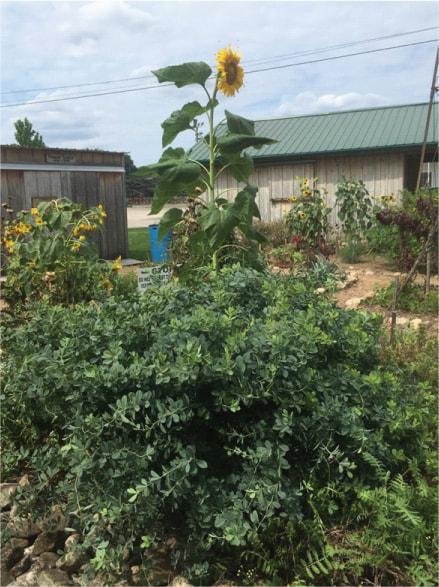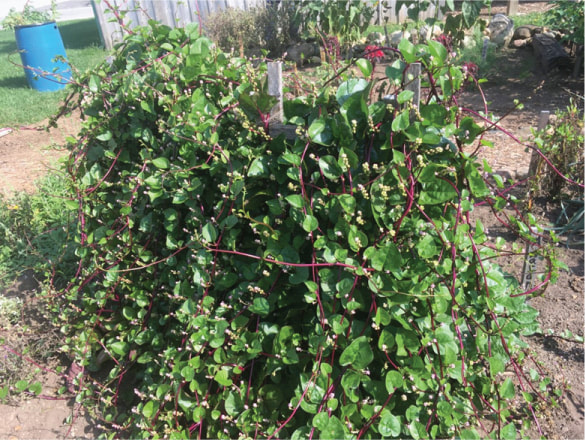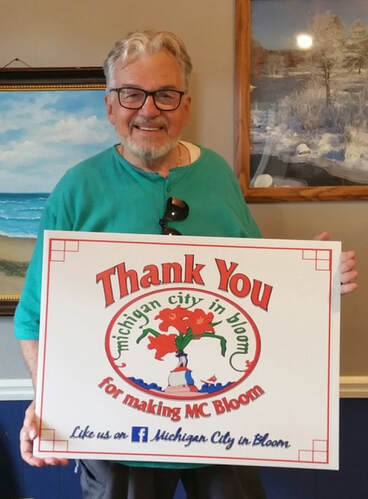LaPorte County Master Gardeners Association
ATTENTION
We are launching a new website - https://www.lpmastergardener.org
This current www.lpmastergardener.com website will be taken down November 1, 2021.
Please explore and use the new site and be sure to bookmark the new link: https://www.lpmastergardener.org
We are launching a new website - https://www.lpmastergardener.org
This current www.lpmastergardener.com website will be taken down November 1, 2021.
Please explore and use the new site and be sure to bookmark the new link: https://www.lpmastergardener.org
LaPorte's Sunflower Festival - Saturday Sept 18
Late Summer Pictures from the Pioneer Garden
The Master Gardeners of La Porte, Indiana, maintain a heritage garden as part of the Pioneer Village at the La Porte County Fairgrounds. While there’s not enough room there to grow enough to feed a family, it demonstrates the typical plants used by that family in the 1850’s in this part of early America.
Since the settlers came from many parts of the world, they brought their favorite seeds with them to grow the food, medicine, herbs for flavor, dying and flowers to make their homes beautiful.
There’s a lot going on, throughout the year, in this garden. School groups visit spring and fall, to be greeted by a speaker in period dress, and learn about the importance of gardens in family life. During the annual County Fair, hundreds stroll through the gardens, often exclaiming over plants they recognize from “grandma’s garden” and taking home heritage seeds to grow in their own gardens.
These pictures show some of the late season bounty that grew in that garden even in this tough growing year.
Sunflowers
False Indigo (Baptisia Australis) A dye-producing plant yields a blue dye.
Sunflower
Malabar Spinach (Basella Rubra) – I am waiting for seeds to mature on this vining spinach to collect.
Shoo-Fly (Nicandra physaloides) – Said to repel flies in home and garden. Has sky-blue flowers and papery husks enclose round seed pods.
Broom Corn (Sorghum bicolor) – A type of sorghum used by pioneer village craft workers to make brooms.
Toothache Plant (Spilanthes) – used to treat toothaches causing numbing in the gums when chewed.
Flowers found in the cutting garden section.
Seeds are left in the pioneer garden for consumption by winter wildlife.
Asparagus is cut back after it has dried to return next year.
Flax (Linum Usitatissimum) – A perennial native wildflower used for linen, thread, and cloth. Produces beautiful blue flowers.
Clay Sage (Salvia Virrdids, S. Horminum) – Has beautiful purple bracts from which oil is extracted to be used for its anti-bacterial properties and aroma therapy.
The Master Gardeners of La Porte, Indiana, maintain a heritage garden as part of the Pioneer Village at the La Porte County Fairgrounds. While there’s not enough room there to grow enough to feed a family, it demonstrates the typical plants used by that family in the 1850’s in this part of early America.
Since the settlers came from many parts of the world, they brought their favorite seeds with them to grow the food, medicine, herbs for flavor, dying and flowers to make their homes beautiful.
There’s a lot going on, throughout the year, in this garden. School groups visit spring and fall, to be greeted by a speaker in period dress, and learn about the importance of gardens in family life. During the annual County Fair, hundreds stroll through the gardens, often exclaiming over plants they recognize from “grandma’s garden” and taking home heritage seeds to grow in their own gardens.
These pictures show some of the late season bounty that grew in that garden even in this tough growing year.
Sunflowers
False Indigo (Baptisia Australis) A dye-producing plant yields a blue dye.
Sunflower
Malabar Spinach (Basella Rubra) – I am waiting for seeds to mature on this vining spinach to collect.
Shoo-Fly (Nicandra physaloides) – Said to repel flies in home and garden. Has sky-blue flowers and papery husks enclose round seed pods.
Broom Corn (Sorghum bicolor) – A type of sorghum used by pioneer village craft workers to make brooms.
Toothache Plant (Spilanthes) – used to treat toothaches causing numbing in the gums when chewed.
Flowers found in the cutting garden section.
Seeds are left in the pioneer garden for consumption by winter wildlife.
Asparagus is cut back after it has dried to return next year.
Flax (Linum Usitatissimum) – A perennial native wildflower used for linen, thread, and cloth. Produces beautiful blue flowers.
Clay Sage (Salvia Virrdids, S. Horminum) – Has beautiful purple bracts from which oil is extracted to be used for its anti-bacterial properties and aroma therapy.
From Nicole Messacar, Project Wingspan Coordinator
Project Wingspan
The goal of the project is to increase landscape level habitat for the monarch butterfly and rusty-patched bumblebee.
I'm looking for folks to be involved in one of three ways.
1. Volunteer Seed Collectors
2. Volunteer Team Leads
3. Sites to collect on
They provide on-line training for the Volunteer Seed Collectors and a next-level training for folks that would like to be Team Leads. You can find more about the Project here:
https://www.pollinator.org/wingspan
We will bring more information about this opportunity to the next meeting (the picnic/auction) on August 5!
Nicole Messacar
Project Wingspan Indiana State Coordinator
Pollinator Partnership
e: [email protected]
w: www.pollinator.org
p: 219.221.2429
LaPorte, IN
Head Office:
475 Sansome St., 17th Floor
San Francisco, CA 94111
(415) 362-1137
Project Wingspan
The goal of the project is to increase landscape level habitat for the monarch butterfly and rusty-patched bumblebee.
I'm looking for folks to be involved in one of three ways.
1. Volunteer Seed Collectors
2. Volunteer Team Leads
3. Sites to collect on
They provide on-line training for the Volunteer Seed Collectors and a next-level training for folks that would like to be Team Leads. You can find more about the Project here:
https://www.pollinator.org/wingspan
We will bring more information about this opportunity to the next meeting (the picnic/auction) on August 5!
Nicole Messacar
Project Wingspan Indiana State Coordinator
Pollinator Partnership
e: [email protected]
w: www.pollinator.org
p: 219.221.2429
LaPorte, IN
Head Office:
475 Sansome St., 17th Floor
San Francisco, CA 94111
(415) 362-1137
2021 La Porte County Fair - Pioneer Garden
A big Pioneer Thank You to everyone who helped at the garden this year, we had several new faces and they even agreed to dress up and give tours during the Fair. I hope they enjoyed the experience. I enjoyed the Master Gardener’s eagerness to learn and their commitment to our Pioneer project.
We had rain/mist on most days and this caused the plants to grow along with the weeds. Our resident bunny didn’t mind the weather and ran frantically around the garden during the first days of the Fair. He has apparently recovered and is back and eating at the salad bar. Naturally, he doesn’t care to eat weeds.
We received many pleasant comments about the garden and especially about the unusual plants; Shoo-Fly, Malabar Spinach and Asparagus that has gone to seed generated many conversations.
Our garden work is not done. We have potatoes to dig and tomatoes and pickles to harvest. The bunny ate a great deal but we will still have vegetables to share at a community food bank. Happy gardening to all!
Connie Shei
Class of 2021
Pioneer Garden Chairman
We had rain/mist on most days and this caused the plants to grow along with the weeds. Our resident bunny didn’t mind the weather and ran frantically around the garden during the first days of the Fair. He has apparently recovered and is back and eating at the salad bar. Naturally, he doesn’t care to eat weeds.
We received many pleasant comments about the garden and especially about the unusual plants; Shoo-Fly, Malabar Spinach and Asparagus that has gone to seed generated many conversations.
Our garden work is not done. We have potatoes to dig and tomatoes and pickles to harvest. The bunny ate a great deal but we will still have vegetables to share at a community food bank. Happy gardening to all!
Connie Shei
Class of 2021
Pioneer Garden Chairman
Congratulations to Dennis Brittain - Our very own local celebrity!!!
2021 Awards Dinner at Red Mill Park
Thirty Eight Master Gardener members and guests attended the annual Awards Dinner held at Red Mill County Park June 3rd. It was the first in-person meeting for most of us in over a year, and there was lots of joy in seeing long time friends we hadn’t seen other than on a zoom meeting screen.
This event is usually a carry-in dinner with lots of desserts and salads, but for safety’s sake, this year’s meal was catered in from a local grocery store, and carefully served by board members in gloves.
The purpose of this annual event is to recognize the many hours of volunteer work done by the members who receive an award based on their accumulated hours of work. That work covers so many projects. It’s also time to sign on for our upcoming projects and to pick up the annual member’s directory.
Special guests for the evening were Walt Sell, and Gene Matzat, both former Extension Coordinators who supervised the Master Gardener program in LaPorte County, along with Azad Chahal, current Program Coordinator. Gene was the guest speaker-story in a separate article.
Azad Chahal handed out awards, assisted by Tina DeWitt.
Master Gardener Interns, Class of 2020 were: Bethany Branco, Jacqueline Carroll, Janice Colwell, Pam Cook, Jenifer Hawkins, Marcia Kozelka, Robert Kozelka, Carol Lawrenz, Cindy Pagels, William Sabathne and Victoria Sparks.
Master Gardener Certificate award went to: Nicole Krol, and Maureen Sherrick, both Class of 2018.
Advanced Master Gardeners: Randa Magill, 2018, Julie Rice Zurek, 2018, Joe Szynal, 2018, and Estelle Pawloski,2015, who also earned her Bronze Master Gardener Certificate.
Silver Master Gardener Awards went to Carolyn Gardner, 2004, and Julie Goetz, 2015.
An amazing Gold 5000 award went to Sharon Cholewa.
Those who were not in attendance, will receive their awards at a future meeting.
This event is usually a carry-in dinner with lots of desserts and salads, but for safety’s sake, this year’s meal was catered in from a local grocery store, and carefully served by board members in gloves.
The purpose of this annual event is to recognize the many hours of volunteer work done by the members who receive an award based on their accumulated hours of work. That work covers so many projects. It’s also time to sign on for our upcoming projects and to pick up the annual member’s directory.
Special guests for the evening were Walt Sell, and Gene Matzat, both former Extension Coordinators who supervised the Master Gardener program in LaPorte County, along with Azad Chahal, current Program Coordinator. Gene was the guest speaker-story in a separate article.
Azad Chahal handed out awards, assisted by Tina DeWitt.
Master Gardener Interns, Class of 2020 were: Bethany Branco, Jacqueline Carroll, Janice Colwell, Pam Cook, Jenifer Hawkins, Marcia Kozelka, Robert Kozelka, Carol Lawrenz, Cindy Pagels, William Sabathne and Victoria Sparks.
Master Gardener Certificate award went to: Nicole Krol, and Maureen Sherrick, both Class of 2018.
Advanced Master Gardeners: Randa Magill, 2018, Julie Rice Zurek, 2018, Joe Szynal, 2018, and Estelle Pawloski,2015, who also earned her Bronze Master Gardener Certificate.
Silver Master Gardener Awards went to Carolyn Gardner, 2004, and Julie Goetz, 2015.
An amazing Gold 5000 award went to Sharon Cholewa.
Those who were not in attendance, will receive their awards at a future meeting.
Gene Matzat in Retirement
Gene Matzat retired as our Extension Coordinator last year and returned to the Awards Dinner as our Main Speaker to update us on his work since retirement. Besides farming his land for hay, he has been coordinating the Matzat Wetlands Project. He and his wife purchased their original 80 acre farm many years ago, and added on an adjoining farm recently. Much of the land was Classified Forest and much Wildlife Habitat.
There was a small meandering stream and some small ponds on the properties, and lots of the invasive plants that occur everywhere. For the past years, Gene and his wife have worked to eliminate many of those, but some needed more concentrated work.
With state and county expert help, they launched the project to eliminate much of the wet land without good drainage, remove the invasive plants that were stopping the more productive native plants from growing, and increase habitat for migrating and native wildlife. They filled in and created a more efficient drainage ditch and created better ponds to sustain healthy wildlife. This also will prevent pollution and silt from washing downstream. This control helps not only the environment on their own land, but benefits downstream lands as well. Results quickly showed up as sandhill cranes and others appeared soon to make their home in the new place.
Once that huge project was finished, they build a 4’ by 4’ nesting box and applied to local county agencies for help to erect a 50’ tall pole to put the nesting box high in the air near the ponds in hopes of attracting osprey.
Gene repeated that he is working hard, harvesting hay and taking care of his land and enjoying seeing the results as nature responds to the improved environment. He invited the Master Gardeners to come for a field trip to see the results, but encouraged us to be prepared to help pull garlic mustard as we hike his trails on our visit.
Where have all the Cicadas Gone?
By: Gina Alber, LPMGA Co-Secretary. June 14, 2021
This year we all have anxiously awaited the arrival of the every 17 years invader, cicadas! All of this hype yet…Where are the cicadas!? I personally readied myself with armor (shoes, who wants to step barefoot on them, right?), and my phone so I could record this amazing arrival, but have been disappointed to not see any in my hometown or immediate area…. Because I am so interested in this occurrence, I decided to dig a bit further and see what I could find out from state experts on this phenomenon.
Experts report that southern Indiana saw them beginning to emerge in late May to now and when they emerge it is en masse. Timothy J. Gibb, from the Purdue University Department of Entomology’ said in a March 2, 2021 interview with the Indy Star that the event is a spring break for bugs of sorts…. A big time party scene results anywhere there are masses of them. I find that hilarious, picturing these gross, red skinned, huge-eyed bugs trying to appeal to the opposite sex and well, you know, grow the colony. Males call females and use internal muscles which rustle and make that shrill sound. There is a very tight membrane that vibrates making the shaking sound. Males congregate and females come over ( just like human college students’ spring break lol) and they lure the females over to them to mate.
Where can I expect to see them?? Brood X cicadas emerge when the soil temperature reaches 64 degrees and often after a warm rain. Groups of them are emerging in Bloomington and southern areas like Louisville. It is likely that birds are picking off the males as they emerge adding to the strategy that they emerge en masse every 17 years to overwhelm their predators. Elizabeth Barnes, an exotic forest pest educator, explained that Indiana weather in early May has likely caused the delayed arrival of the cicadas.
Once they emerge, they are expected to stay around for a month to six weeks, depending on the weather. There are different types of periodical cicadas, some that emerge every 13 years. Indiana is the epicenter for the current group called Brood X. They are expected to be seen in large numbers in the state at Geist Reservoir, Fort Harrison State Park, Eagle Creek Park, Turkey Run State Park and the Hoosier National Forest. Experts are encouraging people who find them in their yards to photograph them then use Apps such as iNaturalist to document their presence. Go ahead, people, go and find some cicadas in your garden.
Reference: https://www.indystar.com/story/news/environment/2021/05/18/experts-predict-deluge-cicadas-central-indiana-within-week/5128086001/
Experts report that southern Indiana saw them beginning to emerge in late May to now and when they emerge it is en masse. Timothy J. Gibb, from the Purdue University Department of Entomology’ said in a March 2, 2021 interview with the Indy Star that the event is a spring break for bugs of sorts…. A big time party scene results anywhere there are masses of them. I find that hilarious, picturing these gross, red skinned, huge-eyed bugs trying to appeal to the opposite sex and well, you know, grow the colony. Males call females and use internal muscles which rustle and make that shrill sound. There is a very tight membrane that vibrates making the shaking sound. Males congregate and females come over ( just like human college students’ spring break lol) and they lure the females over to them to mate.
Where can I expect to see them?? Brood X cicadas emerge when the soil temperature reaches 64 degrees and often after a warm rain. Groups of them are emerging in Bloomington and southern areas like Louisville. It is likely that birds are picking off the males as they emerge adding to the strategy that they emerge en masse every 17 years to overwhelm their predators. Elizabeth Barnes, an exotic forest pest educator, explained that Indiana weather in early May has likely caused the delayed arrival of the cicadas.
Once they emerge, they are expected to stay around for a month to six weeks, depending on the weather. There are different types of periodical cicadas, some that emerge every 13 years. Indiana is the epicenter for the current group called Brood X. They are expected to be seen in large numbers in the state at Geist Reservoir, Fort Harrison State Park, Eagle Creek Park, Turkey Run State Park and the Hoosier National Forest. Experts are encouraging people who find them in their yards to photograph them then use Apps such as iNaturalist to document their presence. Go ahead, people, go and find some cicadas in your garden.
Reference: https://www.indystar.com/story/news/environment/2021/05/18/experts-predict-deluge-cicadas-central-indiana-within-week/5128086001/
May 14, 2021 Spring Office Cleanup
Today, we are working to clean up our native plant beds! Native plants are wonderful for native pollinators, but they do require seasonal love! We are also preparing a weed field guide so other volunteers in the future know what to pull and what to keep!
Thank you Master Gardener volunteers, Marcy, Connie, and Kathleen and Soil and Water Conservation District staff, Nicole, Chris and Michael for the Office Beautification fun this morning. It was a beautiful morning to identify and eradicate the weeds and clean up the native gardens in front of our building. Thank you everyone!!!
Thank you Master Gardener volunteers, Marcy, Connie, and Kathleen and Soil and Water Conservation District staff, Nicole, Chris and Michael for the Office Beautification fun this morning. It was a beautiful morning to identify and eradicate the weeds and clean up the native gardens in front of our building. Thank you everyone!!!


























